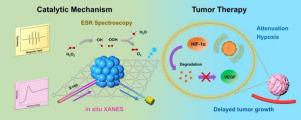当前位置:
X-MOL 学术
›
Nano Today
›
论文详情
Our official English website, www.x-mol.net, welcomes your feedback! (Note: you will need to create a separate account there.)
Graphdiyne-templated palladium-nanoparticle assembly as a robust oxygen generator to attenuate tumor hypoxia
Nano Today ( IF 17.4 ) Pub Date : 2020-10-01 , DOI: 10.1016/j.nantod.2020.100907 Jiaming Liu , Liming Wang , Xiaomei Shen , Xingfa Gao , Yanhuan Chen , Huibiao Liu , Ying Liu , Dongtao Yin , Yang Liu , Wei Xu , Rong Cai , Min You , Mengyu Guo , Yaling Wang , Jiayang Li , Yuliang Li , Chunying Chen
Nano Today ( IF 17.4 ) Pub Date : 2020-10-01 , DOI: 10.1016/j.nantod.2020.100907 Jiaming Liu , Liming Wang , Xiaomei Shen , Xingfa Gao , Yanhuan Chen , Huibiao Liu , Ying Liu , Dongtao Yin , Yang Liu , Wei Xu , Rong Cai , Min You , Mengyu Guo , Yaling Wang , Jiayang Li , Yuliang Li , Chunying Chen

|
Abstract Nanocatalysts have attracted many concerns in biomedical fields because their catalytic performance is robust and remains efficient even at a harsh condition compared to biological enzymes. However, the stability for both physical forms and the catalytic activity are the main challenges during biomedical applications. Here, we described a strategy to prepare a stable nanocatalyst that two-dimensional (2D) graphdiyne (GDY) serves as a template to immobilize catalytic palladium nanoparticles (PdNPs) on the GDY surface. In the presence of H2O2, the PdNPs/GDY composite functions as an oxygen generator to decompose H2O2 to produce molecular oxygen, which efficiently attenuates tumor hypoxia and delays tumor growth. According to X-ray absorption spectroscopy and computational simulation, we revealed that PdNPs mainly contribute to the decomposition of H2O2 into O2 companying with the variation in chemical forms of Pd in the presence of H2O2. Importantly, 2D GDY firmly anchors and disperses ultra-small PdNPs on the surface via Pd-C bonds to prevent the oxidation and aggregation of PdNPs that realizes sustainable and stable catalysis. This design endows the highly immobilized content of Pd on GDY, high catalytic activity and higher stability in catalytic reaction than commercial Pd/C and PdNPs/GO, accordingly. The PdNPs/GDY composite also exhibits as an effective and durable oxygen generator to decompose endogenous H2O2 and produces O2 inside solid tumors, attenuates tumor hypoxia, down-regulates HIF-1α expression and ultimately delays tumor growth in both human patient-derived squamous cell lung carcinoma xenograft model and 4T1 breast cancer xenografted mouse model. Moreover, in the combination with the chemotherapeutic agent, doxorubicin, PdNPs/GDY-based catalytic therapy achieved a significantly enhanced antitumor effect. Our findings demonstrate that the rational design of a nano-modulator for tumor hypoxia with long term stability is a promising way to enhance the outcome of tumor therapy.
中文翻译:

石墨炔模板钯纳米粒子组装作为强大的氧气发生器,以减轻肿瘤缺氧
摘要 纳米催化剂在生物医学领域引起了许多关注,因为与生物酶相比,它们具有强大的催化性能,即使在恶劣的条件下也能保持高效。然而,物理形式和催化活性的稳定性是生物医学应用过程中的主要挑战。在这里,我们描述了一种制备稳定纳米催化剂的策略,二维 (2D) 石墨炔 (GDY) 作为模板将催化钯纳米粒子 (PdNPs) 固定在 GDY 表面上。在 H2O2 存在下,PdNPs/GDY 复合材料作为氧气发生器分解 H2O2 产生分子氧,从而有效地减弱肿瘤缺氧并延缓肿瘤生长。根据 X 射线吸收光谱和计算模拟,我们发现 PdNPs 主要有助于 H2O2 分解为 O2,伴随着 H2O2 存在下 Pd 化学形式的变化。重要的是,2D GDY通过Pd-C键将超小PdNP牢固地锚定和分散在表面上,以防止PdNP的氧化和聚集,实现可持续稳定的催化。因此,该设计赋予了 GDY 上高固定化 Pd 含量、高催化活性和比商业 Pd/C 和 PdNPs/GO 更高的催化反应稳定性。PdNPs/GDY 复合材料还表现出作为一种有效且耐用的氧气发生器来分解内源性 H2O2 并在实体瘤内产生 O2,减轻肿瘤缺氧,在人类患者来源的鳞状细胞肺癌异种移植模型和 4T1 乳腺癌异种移植小鼠模型中,下调 HIF-1α 表达并最终延迟肿瘤生长。此外,与化疗药物多柔比星、基于 PdNPs/GDY 的催化疗法联合使用时,抗肿瘤效果显着增强。我们的研究结果表明,合理设计具有长期稳定性的肿瘤缺氧纳米调节剂是提高肿瘤治疗效果的一种有前途的方法。
更新日期:2020-10-01
中文翻译:

石墨炔模板钯纳米粒子组装作为强大的氧气发生器,以减轻肿瘤缺氧
摘要 纳米催化剂在生物医学领域引起了许多关注,因为与生物酶相比,它们具有强大的催化性能,即使在恶劣的条件下也能保持高效。然而,物理形式和催化活性的稳定性是生物医学应用过程中的主要挑战。在这里,我们描述了一种制备稳定纳米催化剂的策略,二维 (2D) 石墨炔 (GDY) 作为模板将催化钯纳米粒子 (PdNPs) 固定在 GDY 表面上。在 H2O2 存在下,PdNPs/GDY 复合材料作为氧气发生器分解 H2O2 产生分子氧,从而有效地减弱肿瘤缺氧并延缓肿瘤生长。根据 X 射线吸收光谱和计算模拟,我们发现 PdNPs 主要有助于 H2O2 分解为 O2,伴随着 H2O2 存在下 Pd 化学形式的变化。重要的是,2D GDY通过Pd-C键将超小PdNP牢固地锚定和分散在表面上,以防止PdNP的氧化和聚集,实现可持续稳定的催化。因此,该设计赋予了 GDY 上高固定化 Pd 含量、高催化活性和比商业 Pd/C 和 PdNPs/GO 更高的催化反应稳定性。PdNPs/GDY 复合材料还表现出作为一种有效且耐用的氧气发生器来分解内源性 H2O2 并在实体瘤内产生 O2,减轻肿瘤缺氧,在人类患者来源的鳞状细胞肺癌异种移植模型和 4T1 乳腺癌异种移植小鼠模型中,下调 HIF-1α 表达并最终延迟肿瘤生长。此外,与化疗药物多柔比星、基于 PdNPs/GDY 的催化疗法联合使用时,抗肿瘤效果显着增强。我们的研究结果表明,合理设计具有长期稳定性的肿瘤缺氧纳米调节剂是提高肿瘤治疗效果的一种有前途的方法。

























 京公网安备 11010802027423号
京公网安备 11010802027423号